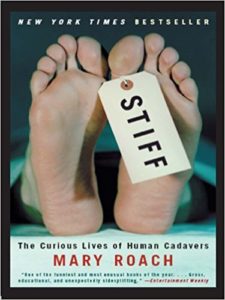 Stiff – The Curious Lives of Human Cadavers is an exploration of what happens to the human body after the person dies. It is not a book for people who are squeamish, or who are mourning a loved one.
Stiff – The Curious Lives of Human Cadavers is an exploration of what happens to the human body after the person dies. It is not a book for people who are squeamish, or who are mourning a loved one.
I would definitely recommend Stiff to writers of mystery or crime novels, who need a good source of information about the timeline in which a cadaver decays. There are some things that people probably shouldn’t Google.
Mary Roach does an excellent job of presenting factual information about a difficult topic to consider, while injecting just the right amount of what might be considered gallows humor. She does this without ever disrespecting the deceased.
Stiff was published in 2003, so it is possible that some of the information in the book might be outdated. I suspect that the majority of it is still valid (but did not take the time to look up things to see what may have changed.) There’s a chance that the medical stuff could have been updated with new techniques between when the book was written and today.
The first chapter of the book is about Mary Roach’s observations as she watches a group of doctors who are practicing face lifting techniques on cadaver heads. Some of the doctors are respectful of the person whose donated head they are working on. Others are less so. Mary Roach wonders who has the job of removing the cadaver heads from the rest of the cadaver – and she finds the answer to that question.
Another chapter goes into the history of body snatchers. For a long time, it was illegal to dissect a dead human body. Anatomists had to resort to not-quite-legal means of obtaining bodies from which to learn about human anatomy.
In some cases, the bodies were supplied by “resurrection men” who unearthed the recently deceased, put the body into a sack, and discretely delivered it to the doctor.
It was apparently a good way to earn some money. It is also the reason that religious people – who believed the body needed to be entirely intact in order for the person to get into heaven – invested in Mortsafes.
In that same chapter, there is an interesting (and disturbing) story about William Burke and William Hare, two “resurrectionists” who got into trouble. A man died in Hare’s boarding house before paying his fare.
Hare and Burke took the body to an anatomist. After learning that bringing dead bodies to anatomists resulted in a nice payment, Hare and Burke started murdering people (and bringing the very recently dead to the anatomists). I’ll leave you to read the chapter to see how this obviously illegal situation was resolved.
There is a chapter about the University of Tennessee’s Anthropological Research Facility – which is a large area of land in which cadavers are placed for the purpose of allowing researchers to study the timeline of decay. Part of the purpose is to assist those who investigate crime scenes.
Other chapters cover a wide range of subjects, including information on whether or not cadavers are used for automobile crash tests. There is a chapter about the ethical issues involved in using cadavers (or cadaver legs) to determine which shoes provide the best protection for a living person who has stepped on a land mine.
One of the chapters that I found especially interesting involved extremely religious Christians, who were alive, and who volunteered to be “crucified”. They weren’t actually nailed to a cross. It was a safely done approximation of crucifixion that involved people being secured to a huge cross by leather straps.
The purpose of the experiment was to debunk previous hypotheses about what Jesus may have experienced. The purpose was to determine whether or not the volunteers had difficulty breathing while on the cross, and to figure out where the nails would have to be placed in order to prevent them from ripping out.
Other oddities found in Stiff include details about an incredibly disturbing experiment where a researcher removed the head of an anesthetized monkey and attached it to the body of an entirely different monkey. There is also an amusing story in which Mary Roach goes to China in an effort to confirm, or debunk, an urban legend about human cadaver parts being used in the dumplings served in a restaurant.
I found Stiff to be interesting, and strange, and filled with historical context that I might not have learned about if I had not read this book. There is definitely a tendency for people who work with cadavers (or parts of human bodies) to think of the cadaver as a person – and not a person – at the same time.
Medical students, who must take a course that involves dissection of human cadavers, end up with a mix of emotions. They must, at times, distance themselves from considering the cadaver as a person. At the same time, many students form emotional attachments to the cadaver.
This results in the university holding a mass funeral for the cadavers at the end of the semester. Students eulogize about the cadaver they worked on. It is a way of letting go, and thanking the person who donated their body to science, at the same time.
Stiff – by Mary Roach is a post written by Jen Thorpe on Book of Jen and is not allowed to be copied to other sites.
If you enjoyed this blog post please consider supporting me on Ko-fi. Thank you!

One comment